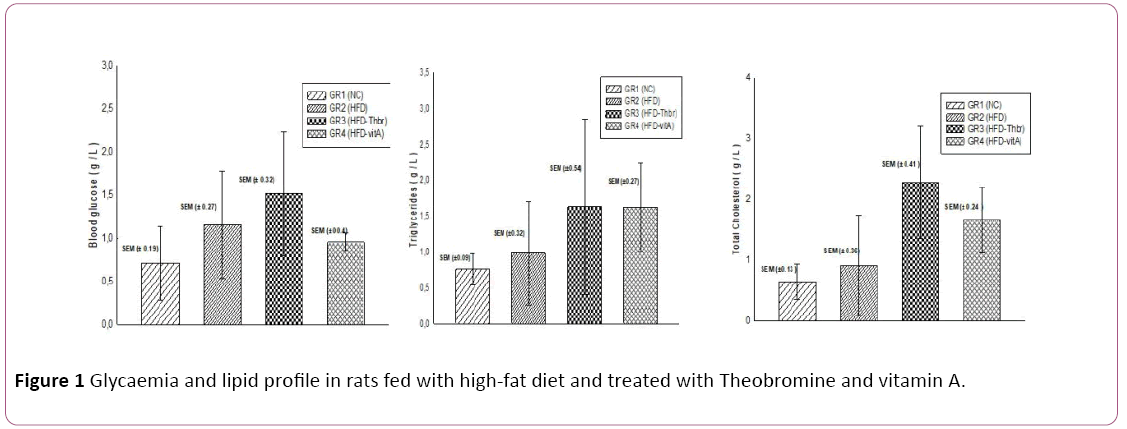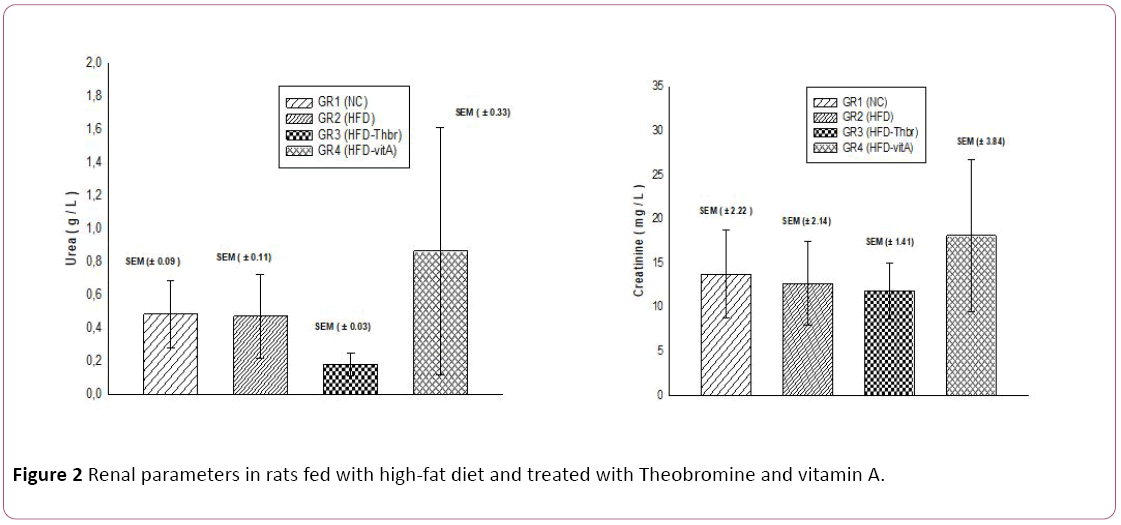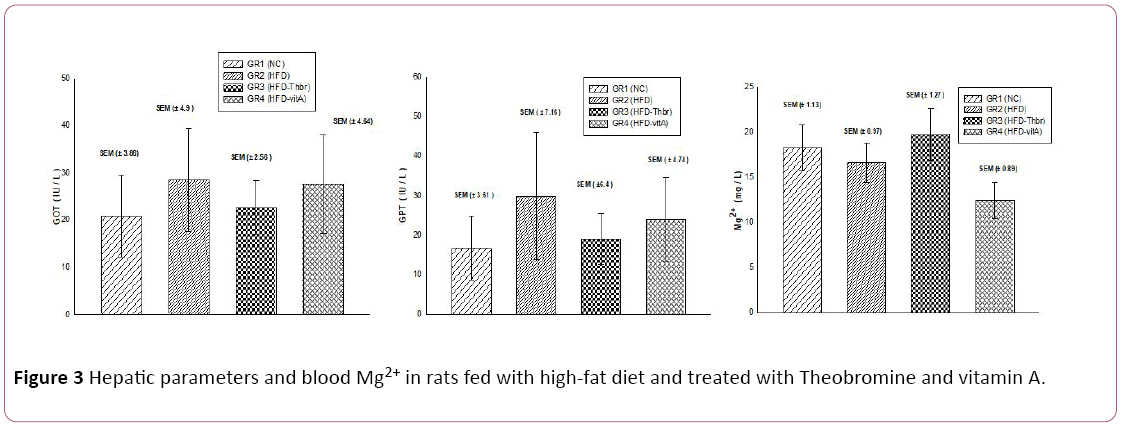Keywords
Dark chocolate; Magnesium; Theobromine; Vitamins; Atherosclerosis
Introduction
Previous epidemiological studies showed fruits, vegetables, almonds and green tea intakes were associated with a decrease in the cardiovascular disease incidence [1]. Foods are a source of phenolic acids, flavonoids and trace elements with preventive pharmacological properties against these diseases. Dark chocolate, or cocoa, is a food rich in flavonoids, mainly theobromine, and in trace elements such as Magnesium. Several studies have suggested an inverse association with atherosclerosis or stroke risk. A study, led on 13 healthy patients under dark chocolate diet during 14 days, revealed a positive association with a decrease in blood pressure [2]. In vitro and in vivo studies also suggested Magnesium inhibits the formation of atheromatous plaques in the arteries and thus their calcification [3]. Among phenolic compounds, present in dark chocolate, are mentioned Theobromine, Flavan-3-Ols, Catechin, Epicatechine and Proanthocyanidin [3]. Bioactive molecules have an antioxidant activity including scavenging reactive oxygen species (ROS) or free radicals generated through oxidative stress. ROS promote functional disruption of the cell membrane and also chelating metal ions which induces changes of the cell membrane redox potential [4]. Phenolic compounds, tannins, flavonoids and trace elements promote the protection and resistance of vascular walls involving cell defense mechanisms and the slowing down of platelet activity in the arteries to prevent the blood clots synthesis [3]. According to dietician's recommendations and the rules of the balanced diet, dark chocolate intake should be associated with fruits and vegetables rich in different vitamins and trace elements to reduce the risk of cardiovascular diseases mainly atherosclerosis and cerebrovascular accidents or stroke. This present study aimed to compare theobromine dark chocolate extract and vitamin A on biochemical variables in rats fed with high-fat diet or cafeteria diet.
Material and Methods
Dark chocolate and vitamin A
Dark chocolate bars were purchased at local grocery store. A labeled dark chocolate showed nutritional and energy values for 100 g such as caloric intake (544 kcal), proteins (7.5 g), carbohydrates (61.05 g) and fats (30 g); ingredients (sugar, cocoa powder and cocoa butter) and Emulsifiers (soy lecithin, vanilla and aromas).
Vitamin A, in liquid form, was purchased at local pharmacy. The drug leaflet showed a composition; active ingredient (Retinol at a dose 15000 IU) and excipients (Polyoxyethylenated castor oil, glycerol, sodium hydrogen phosphate dihydrate, sodium hydrogen phosphate decahydrate, sodium edetate, benzalkonium chloride and purified water).
Dark chocolate aqueous extract
Amount of 50 g dark chocolate, cut in small pieces, was dissolved in 1000 mL boiled distilled water. The dark chocolate aqueous extract was vacuum filtered and left decanted during 2 hours. A volume 20 mL of dichloromethane was added to the extract. The organic phase, containing theobromine, was separated from the aqueous phase. The organic phase was collected in an ice bath and left for two days. Hydrochloric acid was added to the extract to neutralize the acidity. The theobromine aqueous extract obtained was stored at 4°C.
Preparation of vitamin A solution
Ten drops of vitamin A were diluted in 100 mL of distilled water. Vitamin A solution was stored at 4°C.
Cafeteria diet
The high-fat-diet was prepared according to the protocol of Pouteau et al. The cafeteria diet consisted of standard diet (50%) and a mixture (50%) of sausage, biscuits, cheese, chips, peanut, chocolate in proportions 2: 2: 2: 1: 1: 1 [5].
Experimental design
Forty adult male rats, weighting 150-200 g, were purchased from Pasteur Institute, Algiers, Algeria. Animals were housed in plastic cages, under controlled conditions (25°C, 12 hours light/dark cycle) and had access to standard diet and water ad libitum.
Forty animals were divided into four Groups (10 rats/ Group), as follow:
Group 1: Normal control animals fed with standard diet and tap water,
Group 2: Experiment control animals fed with high-fat diet (200 g/day)
Group 3: Animals, under cafeteria diet, orally administrated with dark chocolate aqueous extract at dose 10 mg/kg bw (~1/10 of LD50: 100-250 mg/kg bw) [6].
Group 4: Animals, under cafeteria diet, orally administrated with vitamin A at dose 700 mg/kg bw (~<1/10 of LD50: 7910 mg/kg bw) [7].
Anthropometrical and biochemical studies
Body weight of animals was measured during the two last weeks of experiment duration (40 days). Blood glucose was recorded every 8 days. Food and water intake were monitored daily. Blood samples were taken from the tail tip of animals to measure glycaemia. Blood glucose levels (g/L) were determined by means of Accu-Chek glucometer. Blood glucose reactive test based on enzymatic reaction namely glucose oxidase method. Other biochemical parameters such as serum triglycerides, total-cholesterol, urea, creatinine, glutamic oxaloacetic transaminase (GOT), glutamic pyruvic transaminase (GPT) urea, creatinine and blood magnesium (Mg2+) were also estimated every 8 days using an automateanalyzer “mini-VIDAS” (Bio Merieux Laboratories, Lyon, France).
Statistical analysis
Data were performed with SigmaPlot (version 11.0) software. Results were presented as a mean value ± standard error of the mean (SEM) by using analysis of variance (ANOVA) followed with Tuckey's test to assess significant differences of results, with p < 0.05 as the criterion of significance.
Results
Results showed highly significant (p=0.001) increase in body weight and body weight gain in animals fed with high-fat diet and treated with vitamin A (Group 4) (respectively 228.06 ± 3.77 g and 1.40 ± 0.33%) compared to controls (Group 1) and other animals (Groups 2 and 3) (Table 1). Whereas blood glucose and triglyceride levels did not show significant different results in all groups of animals (p=0.227 and p=0.223 respectively) (Table 1 and Figure 1).
| Variables (± SEM) |
Group 1
(Controls) |
Group 2
(HFD) |
Group 3
(HFD-Thbr) |
Group 4
(HFD-vitA) |
p-value |
| Body weight (g) |
163.23±1.52 |
196.12±1.78 |
194.43±2.44 |
228.06±3.77 |
0.001 |
| Body weight gain (%) |
0.54 ± 0.13 |
0.46 ± 0.15 |
-1.05 ± 0.2 |
1.40 ±0.33 |
0.001 |
| Blood glucose (g/L) |
0.71 ± 0.19 |
1.16 ± 0.27 |
1.51 ± 0.32 |
0.96 ± 0.04 |
0.227 |
| Triglyceride (g/L) |
0.76 ± 0.09 |
0.98 ± 0.32 |
1.63 ± 0.54 |
1.62 ± 0.27 |
0.223 |
| T-cholesterol (g/L) |
0.65 ± 0.13 |
0.91 ± 0.36 |
2.28 ± 0.41 |
1.66 ± 0.24 |
0.007 |
| Urea (g/L) |
0.48 ± 0.09 |
0.47 ± 0.11 |
0.18 ± 0.03 |
0.86 ± 0.33 |
0.135 |
| Creatinine (mg/L) |
13.73 ± 2.22 |
12.7 ± 2.14 |
11.82 ± 1.41 |
18.10 ± 3.84 |
0.349 |
| GOT (IU/L) |
20.8 ± 3.86 |
28.4 ± 4.9 |
22.6 ± 2.56 |
27.6 ± 4.64 |
0.498 |
| GPT (IU/L) |
16.6 ± 3.61 |
29.8 ± 7.16 |
19.0 ± 6.4 |
24.0 ± 4.74 |
0.269 |
| Mg2+ (mg/L) |
18.20 ± 1.13 |
16.52 ± 0.97 |
19.71 ± 1.27 |
12.40 ± 0.89 |
0.001 |
| SEM: Standard Error of Mean, HFD: High-Fat Diet, GOT: Glutamic Oxaloacetic Transaminase, GPT: Glutamic Pyruvic Transaminase, Thbr: Theobromine, Vita: Vitamin A. |
Table 1: Variation of biochemical parameters in rats, under cafeteria diet, treated with theobromine aqueous extract and vitamin A.

Figure 1: Glycaemia and lipid profile in rats fed with high-fat diet and treated with Theobromine and vitamin A.
Glycaemia and blood triglyceride level were slightly elevated in animals fed with high-fat diet (1.16 ± 0.27 and 0.98 ± 0.32 g/L), animals treated with theobromine or dark chocolate extract (1.51 ± 0.32 and 1.63 ± 0.54 g/L) and animals treated with vitamin A (0.96 ± 0.04 and 1.62 ± 0.27) compared to controls. Whereas blood total-cholesterol level was extremely highly significant (p=0.007) in Groups 3 and 4 (2.28 ± 0.41 and 1.66 ± 0.24 g/L respectively) (Table 1 and Figure 1). Regarding blood urea and creatinine levels, results revealed nonsignificant values (p=0.135 and p=0.349 respectively) (Table 1 and Figure 2). The analysis of hepatic transaminases (GOT and GPT) also did not record significant results (p=0.498 and p=0.269 respectively). While the presence of Magnesium, as trace elements, in the blood of animals under cafeteria diet and treated with theobromine dark chocolate extract was highly significant (p=0.001) compared to animals administrated with vitamin A in the same experiment conditions and controls. An increased plasma Mg2+ level was mainly observed in animals of Groups 2 and 3 (16.52 ± 0.97 and 19.71 ± 1.27 mg/L respectively) unlike animals of Group 3 showed decreased plasma Mg2+ concentration (12.40 ± 0.89 mg/L) (Table 1 and Figure 3).

Figure 2: Renal parameters in rats fed with high-fat diet and treated with Theobromine and vitamin A.

Figure 3: Hepatic parameters and blood Mg2+ in rats fed with high-fat diet and treated with Theobromine and vitamin A.
Discussion
Through this study, authors assessed the preventive effects of dark chocolate intake, in theobromine aqueous extract form, against metabolic disorders (hyperglycemia, hyperlipidemia and hypercholesterolemia) in an animal model. Dark chocolate is food rich Magnesium. The results of this study are in concordance with this data. Dark chocolate extract, orally administrated to rats, showed a hyperglycemia, hypercholesterolemia and hyperlipidemia. This food is rich in carbohydrate and fat, mainly saturated fatty acids. Dark chocolate has no hypolipedemic effects on plasma lipids and studies are discordant on the subject. It has been reported a non-significant theobromine effects on hypercholesterolemia [8]. Dark chocolate is also rich in minerals, mainly potassium (K) and magnesium (Mg) whose consumption is associated with beneficial effects on arterial vasomotricity and blood pressure [9,10]. The American “Dietary Approaches to Stop Hypertension (or DASH) diet" study proposed a diet enriched in K, Mg and Calcium, through a significant intake of fruits and vegetables, which resulted in a marked decrease in blood pressure in hypertensive subjects [11]. In controversial studies, it was also shown that micronutrient intake is inversely associated with decreased blood pressure [12]. Magnesium (abundant in green vegetables, almonds, coffee and dark chocolate) can play a protective role against cardiovascular disease and stroke [13]. In some American communities in Hawaii where the atherosclerosis risk is high, increased serum magnesium was revealed to be associated with a low coronary disease risk [14]. Food survey, carried out in northern India, has shown that dietary magnesium intake was associated with a lower risk of atherosclerosis [15]. Dark chocolate is also a source of phenolic compounds and flavonoids with attractive pharmacological properties. A diet rich in fruits, vegetables and dark chocolate was associated with a low risk of cardiovascular disease and a decrease in blood pressure [16,17]. Consumption of 100 g/day of dark chocolate for 14 days in 13 patients is also associated with a statistically significant decrease in blood pressure [17,18]. Phenolic compounds have inhibitory effects on the cholesterol intestinal absorption. The chemical structure of flavonoids has an anti-oxidant effect, scavenging ability of free radicals and occurring as a chelator of metal ions [4,19]. Bioactive compounds are involved in defense mechanisms, vascular wall resistance and decreased risk of blood clots [20]. Animals treated with vitamin A, in this study, showed antagonistic effects on blood Mg, glucose, cholesterol and triglyceride levels compared with animals treated with theobromine dark chocolate extract. In the literature, no studies have been conducted to evaluate vitamin A effects on hyperglycemia and lipid dysfunction. The investigating vitamin A preventive effects, led in our study, could not be compared to other baseline studies because the idea that vitamin A has protective activity against metabolic disorders never been thought by the scientific community. Although vitamin A is present in fruits and vegetables, its role remains limited only to ocular vision, growth, immune function, genitalia and normal cell differentiation.
Conclusion
This study, joining the previous work, suggests the moderate protective effects of Magnesium and phenolic compounds towards blood glucose and lipid parameters. The results of this study are preliminary and encouraging, deserving confirmation and a continuation from the scientific community to identify and isolate all the anti-oxidant compounds whose crucial role is the modulation of metabolic disorders. This requires stateof- the-art analytical methods such as high performance liquid chromatography (HPLC).
Future Perspectives
Prevention of cardiovascular disease is to preserve our health. In addition to medication, lifestyle changes can have a major impact in combating the burden of these conditions, including atherosclerosis. Regular physical activity combined with a diet rich in fruits and vegetables may be associated with a lower risk of coronary heart disease. However dark chocolate has received much attention in recent years. It is consumed worldwide because it is an important source of Magnesium and phenolic acids and flavonoids. Conclusive studies have shown the beneficial effect of these factors in regulating the course of cardiovascular disease and blood pressure.
References
- Djoussé L, Hopkins PN, North KE, Pankowe JS, Arnett DK, et al. (2011) Chocolate consumption is inversely associated with prevalent coronary heart disease: The National Heart, Lung, and Blood Institute Family Heart Study. Clin Nutr 30: 182-187.
- Taubert D, Berkels R, Roesen R, Klaus W (2003) Chocolate and blood pressure in elderly individuals with isolated systolic hypertension. J Am Med Assoc 290: 1029-1030.
- Hruby A, O’Donnell CJ, Jacques PF, Meigs JB, Hoffmann U, et al. (2014) Magnesium intake is inversely associated with coronary artery calcification. JACC: Cardiovascular Imaging 7: 59-69.
- Rice-Evans CA, Miller NJ, Bolwell PG, Bramley PM, Pridham JB (1995) The relative antioxidant activities of plant-derived polyphenolic flavonoids. Free Radic Res 22: 375-383.
- Pouteau E, Turner S, Aprikian O, Hellerstein M, Moser M, et al. (2008) Time course and dynamics of adipose tissue development in obese and lean Zucker rat pups. Int J Obesity 32: 648-657.
- Carson TL (2006) Methylxantines. In: Peterson ME, Talcott PA: Small Animal Toxicology, WB Saunders, USA. p: 845-852.
- Bounias M (2006) General toxicology treaty: From the molecular level to the planetary scale. Paris Springer p: 793.
- Jia L, Liu X, Bai YY, Li SH, Sun K, et al. (2010) Short- term effect of cocoa product consumption on lipid profile: A meta-analysis of randomi zed controlled trials. Am J Clin Nutr 92: 218-225.
- Geleijnse JM, Kok FJ, Grobbee DE (2003) Blood pressure response to changes in sodium and potassium intake: A metaregression analysis of randomised trials. J Hum Hypertens 17: 471-480.
- Whelton PK, Klag MJ (1989) Magnesium and blood pressure: A review of the epidemiologic and clinical trial experience. Am J Cardiol 63: 26-30.
- Sacks FM, Svetkey LP, Vollmer WM, Appel LJ, Bray GA, et al. (2001) Effects on blood pressure of reduced dietary sodium and the Dietary Approaches to Stop Hypertension (DASH) diet. DASH-Sodium Collaborative Research Group. N Engl J Med 344: 3-10.
- Champagne CM (2008) Magnesium in hypertension, cardiovascular disease, metabolic syndrome, and other conditions: a review. Nutr Clin Pract 23: 142-151.
- Geiger H, Wanner C (2012) Magnesium in disease. Clin Kidney J 5: 25-38.
- Liao F, Folsom AR, Brancati FL (1998) Is low magnesium concentration a risk factor for coronary heart disease? The Atherosclerosis Risk in Communities (ARIC) Study. Am Heart 136: 480-490.
- Gartside PS, Glueck CJ (1995) The important role of modifiable dietary and behavioral characteristics in the causation and prevention of coronary heart disease hospitalization and mortality: The Prospective NHANES I Follow-up Study. J Am Coll Nutr 14: 71-79.
- Corti R, Flammer AJ, Hollenberg NK, Luscher TF (2009) Cocoa and cardiovascular health. Circulation 119: 1433-1442.
- Grassi D, Desideri G, Croce G, Tiberti S, Aggio A, et al. (2009) Flavonoids, vascular function and cardiovascular protection. Curr Pharm Des 15: 1072-1084.
- Taubert D, Berkels R, Roesen R, Klaus W (2003) Chocolate and blood pressure in elderly individuals with isolated systolic hypertension. JAMA 290: 1029-1030.
- Kondo K, Hirano R, Matsumoto A, Igarashi O, Itakura H (1996) Inhibition of LDL oxidation by cocoa. Lancet 348: 1514.
- Steinberg FM, Bearden MM, Keen CL (2003) Cocoa and chocolate flavonoids: Implications for cardiovascular health. J American Dietetic Association.




